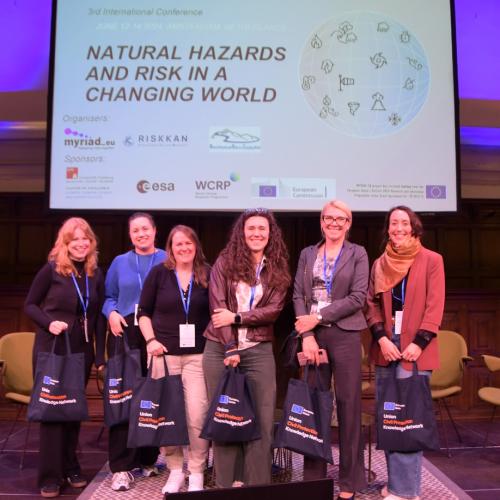
Bringing the science community together on hazards and risks
Bringing the science community together: 3rd International Conference on Natural Hazards and Risks in a Changing World: Addressing Compound and Multi-Hazard Risk.
An old hat-shop and venue for community meetings on environmental issues - the Rode Hoed - provided a fitting backdrop for a gathering of scientists and members of the civil protection community for the 3rd International Conference on Natural Hazards and Risks in a Changing World: Addressing Compound and Multi-Hazard Risk, which took place on 12-13 June in Amsterdam. The conference, organised by EU-funded project MYRIAD-EU, Risk KAN and NatRiskChange, was designed to facilitate engagement between policy makers, scientists, practitioners, and research organisations on compound and multi-hazard risks worldwide. An in-person format was chosen to promote communication and an integrated approach, which are important in reducing risks.
Key speakers included Jenty Kirsch-Wood – UNDRR Head of Global Risk Analysis and Reporting - who talked about the need to ‘understand the DNA of disasters’; making decisions based on digging into recent disasters, rather than in ‘fight or flight mode’. Instead, we need to consider interactions between disasters, putting in place ‘circuit breaker actions’ when hazards escalate into other hazards.
Dr Mariana Madruga de Brito, Department of Urban and Environmental Sociology, UFZ-Helmholtz Centre for Environmental Research, Leipzig, Germany, presented her innovative work on understanding’ messy data’ – using text to analyse the impact of disasters.
Dr Wim Thiery, from Vrije Universiteit Brussel, Department of Water and Climate, asked whether we will live ‘an unprecedented life’, using graphs to show the increasing number of extreme events people can expect to face in their lives, based on the year they were born.
Juha-Pekka Jäpölä represented the European Commission (DG ECHO, Directorate-General for European Civil Protection and Humanitarian Aid Operations, highlighting the Union Civil Protection Mechanism’s role in tackling disasters over the past five years.

Roadmap for 2024-2025
The theme of the conference was extremely relevant for the European Commission as it prepares its scientific needs and roadmap for 2024–2025, as part of the Disaster Risk Management Science and Planning Working Group; multi-risk is likely to be one of the priority areas and meetings like these provide evidence on tools and methods for the way forward. The conference programme included sessions on, for example: Science for policy and practice: synergising disaster risk reduction and climate change, assessing multi-hazard risk using earth-observation data, how stakeholder engagement and knowledge co-production can enhance effective multi-risk management, and artificial intelligence and machine learning for multi-risk assessment.
The conference also provided a timely follow-up to the Civil Protection Forum, which took place on 4-5 June and brought together more than 1,300 policymakers, scientists, and civil protection practitioners to look at innovative ideas on the future of civil protection.
The results of this conference were immediately fed into the Understanding Risk conference at Himeji, Japan by Philip Ward, coordinator of the MYRIAD-EU project.
Supporting Early Career Researchers in the field of civil protection
The European Commission sponsored a group of ten Early Career Researchers to attend the event. Participants were chosen based on their scientific abstracts in UCPM-relevant research, which were presented in a series of posters and presentations over the two days.

Sectors
Risk drivers